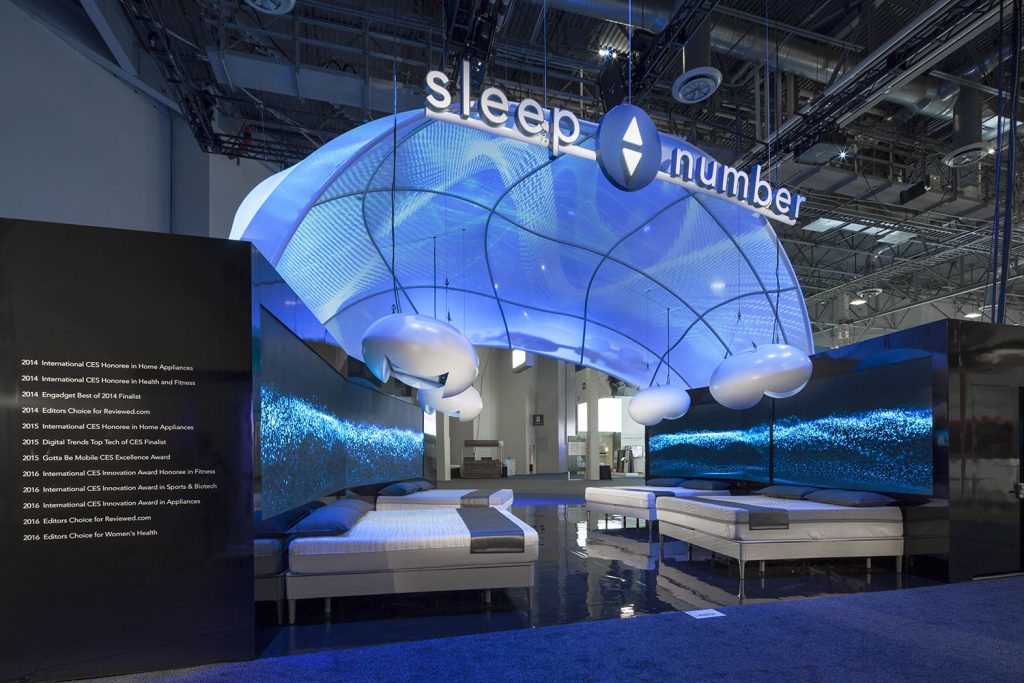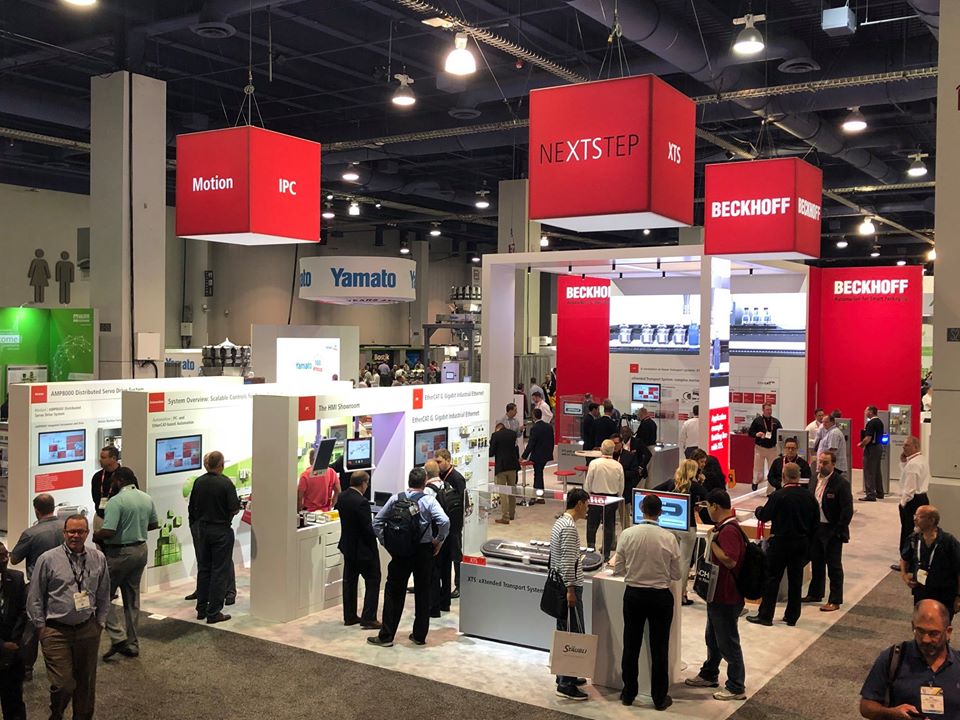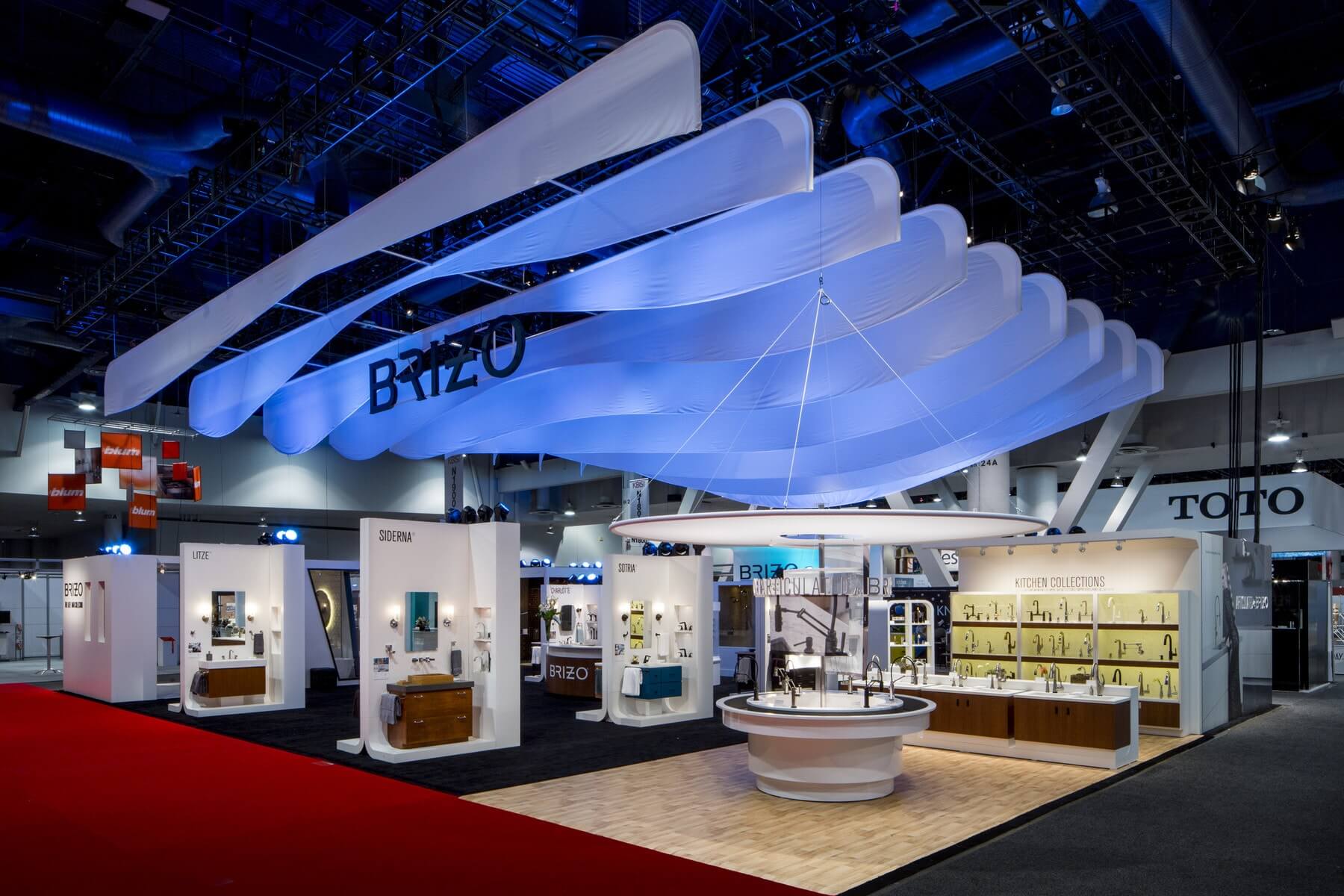Where do you start when you are shopping for a trade show exhibit design? Fortunately (and perhaps unfortunately) you have nearly infinite choices in exhibit style, size, structure, shape, and more.
You could find a picture of attractive exhibit you like and send it to an exhibit house, saying, “Make us something like this!” However, this too often results in a new exhibit that does spark visual interest, but unfortunately greatly misses many of your less obvious yet still important needs.
The reality is that uncovering the truly right exhibit(s) for you takes time and research, and even some debate and compromise.
To help you uncover those important hidden needs, we’ve brought together in this article 10 exhibit design questions for you and your team. Your answers will help your eventual exhibit designer (we hope it’s us!) to avoid exhibits that look good but don’t meet your complete needs.
1. What do we want from trade shows?
It’s surprising how often clients start a design consultation by launching into how many kiosks, tables, and meeting spaces they want, without revealing why they are even exhibiting in the first place. While some of these exhibitors guide the design discussion based on an unstated knowledge of their own needs, too many truly don’t have established strategic sales and marketing goals driving their program.
And knowing what your goals are is extremely important, because they significantly drive your exhibit design:
- If you want awareness, your exhibit will require more branding, splash and perhaps size, and a visual aesthetic that reflects your corporate image.
- If you want leads, your exhibit will need spaces for your booth staff to personally engage with many small groups of booth visitors.
- If you want to display your products (especially new products), you need a design that showcases them.
- And if your goal is lots of meetings with clients, dealers, and other key VIPs, you will need spaces of varying sizes and privacy levels to host those meetings within your booth.
Your team will also likely want a certain level of sales generated and a profitable return on investment. That affects your overall budget – your next question to answer.
2. What should my trade show exhibit budget be?
Let’s start with some simple math: According to Exhibitor Magazine, the average exhibitor spends about 14% of their overall trade show budget on exhibit structure and graphics. So, if you know what your overall trade show budget is, divide it by 7 and you’re there.
But how much should your entire trade show budget be? Consider these factors:
- How much sales revenue have you been generating, and could generate, via trade shows?
- How much sales profit potential do you get from each sale?
- How competitive is your industry show – do other exhibitors go all-in to stand out?
- What percent of your industry’s sales are driven by its major trade shows?
- Do you have strong marketing programs via other media?
A big budgeting clue is how much it costs per square foot of booth space at your shows. Twenty-two dollars a square foot is average. If your booth space costs multiples of that, you know your shows provide access to valuable buyers – and you need to invest meaningfully to attract them.
Here’s another take on your trade show exhibit budget: According to the EDPA, the average cost per square foot of a custom exhibit build is between $145 per square foot (for a linear booth) to $165 per square foot for a single-tier island, and $247 a square foot for a double-deck island.
3. What kind of trade show exhibit should we get?
There are three major categories of trade show exhibits: Portable, Modular, and Custom. They all have their advantages and disadvantages:
- Portable displays set up quickly without tools and pack down into cases you can transport yourself or ship via FedEx or UPS. This portability reduces or eliminates the high cost of shipping, drayage, setup, and dismantle of your exhibit. However, they have limitations in shape, product display, tech integration, and overall brand impact. Very popular for 10 x 10 foot booth spaces, and also some 10 x 20 booth spaces.
- Modular exhibits have greater structural strength and design flexibility than portable displays, but often also require tools for set up. Can be used in virtually any exhibit element, including walls, towers, tables, bridges, and hanging signs. Commonly made with metal extrusions and fabric graphics. They have good brand impact and design capability. They can be used in anything from a 10 x 10 up to a large island exhibit.
- Custom exhibits are made to order to fit the exact needs requested by an exhibitor. Custom exhibits are made by craftsmen who fabricate wood cabinets and metal structures, covered with laminated or other high-value surfaces. When you exhibit in highly valuable and competitive industries, you may need a custom exhibit just to be seen as a contender by potential buyers: don’t bring a knife to a gun fight.
However, you don’t have to choose just one kind of exhibit. You can match the exhibit type to the value of each show on your schedule. For example, one or more portable displays for your small regional and vendor shows, and a custom exhibit for your main industry expo. This is especially true if you exhibit at dozens of shows and need more than one exhibit anyhow.
4. How large should our trade show booth space be?
Your trade show booth space should be big enough to maximize your market opportunity at that show, but small enough that you can also afford to exhibit at other viable shows that can produce excellent sales.
Smaller booths cost less for logistics, and allow you to exhibit at more shows. Bigger booth spaces make it easier to be seen, engage, and demo, and are more memorable after the show.
Consider choosing bigger booths in shows with a great match to your best buyers and other key audiences, and shows that deliver a high ROI. If there’s more opportunity you didn’t tap at the show this year, go bigger. If the show underwhelmed you last year, go smaller, and perhaps drop out if it was a total bust or you have significantly better shows to invest in instead.
5. How many different booth sizes will we use during the year?
Do you only exhibit in 10 x 10 spaces? Or, at the other extreme, do you exhibit in island spaces in a variety of size ranges? Knowing this helps determine the amount of adaptability you need upfront, to save money and time later.
While you already know your range of booth sizes, your exhibit house probably doesn’t. Letting them know when designing your new exhibit can prompt them to create modular components that scale up or down to fit the spaces you’ve committed to. Otherwise, for example, the exhibit you designed for your 30 x 30 space may not fit well into your 20 x 20 space.
Also, if you want to maintain the sophisticated brand look of your custom or modular exhibit at some of your small, high value shows, your exhibit designer can plan ahead of time how to pull a 10 x 20 or even 10 x 10 backwall out of your larger island exhibit.
Finally, be aware the third dimension – height. Some venues have lower height restrictions that could surprise you at installation time, unless you and your exhibit house have planned for it in advance.
And, if you have a major industry show that only happens every two or three years, share that, too. Those tend to be the biggest shows where you’ll need your biggest booth space.
6. How many different attendees/markets will we target during the year?
Even if your booth size is one-size fits all, your message may not be, because you target buyers with different buying criteria. A graphic message that appeals to one group may fall flat with another.
That’s why it’s best to plan for flexibility of graphic messaging, for attendees in different vertical markets, for different product offerings, and possibly for different divisions of your company.
Parts of your exhibit design will likely only require one printed graphic that promotes your overall brand identity. You may want to invest in a set of multiple, market-specific graphics for part of your exhibit structure. Market-specific messages can also be swapped out with digital content that plays on flat screen monitors or even video walls.
We want to know this up front so we can succeed in finding the right balance between your overall brand message, and the specific visual content that matters more for each of your target audiences.
7. How much product should we display in our booth, and how should we display them?
The uncomfortable answer to the question, “How much product to bring?” is “probably not as much as you have been taking.”
Many exhibitors treat their products as a security blanket – better to have them in the booth just in case a client asks about them. And while there is huge value in letting your prospects see, touch, and experience your products first hand, that value gets compromised by a booth too filled with product to comfortably enter.
Think of the 80/20 rule: Bring the 20% of your product that represents 80% of your sales. Or, bring the most popular products in your main product categories. You can rely on other sales tools for the rest.
Product displays work best when they have the attendee in mind: Ensure attendees can see and (if you want) touch your product easily. Design product merchandising that is well-lit, secure, and include graphic or digital content close by that tell your products’ stories.
We can design product showcases that display your products in an organized and elegant fashion. With enough space to avoid clutter, but close enough to each other to invite comparison.
8. Should we rent or buy our trade show exhibits?
Whether you buy or rent your exhibit comes down to economics and flexibility.
Buy your exhibit:
- You should buy your exhibit if you will use it 3 or more times a year in the same booth size. So, that portable display going to 10 shows a year? Buy that for sure.
- However, we have clients who buy their island exhibit even though they use it only once a year, because they do not expect to change their booth layout, space, or brand messaging for several years.
Rent your exhibit:
- Rent your exhibit if you want to make a big impact at a specific show. By renting you can get a bigger exhibit structure and still have more to invest in attention-getting graphics.
- Rent your exhibit if you want to not have your capital tied up in exhibit structures, or if you want to avoid ongoing storage, refurbishing, and in-and-out fees.
- You should rent your exhibit if you will use it only once, maybe twice a year, especially if you want the flexibility to change your design often. This could be because you host ever-changing activities and themed campaigns.
- Rent if you are in a fast-changing industry that expects an evolving brand look every 18 months or so.
- You also may have to rent an exhibit during your busiest parts of your show schedule, when you have two shows overlapping or close together.
Combination:
- You can also combine purchased and rented exhibit components in one booth. For example, you buy your exhibit properties you will use frequently in large inline or small island spaces, and then rent the extra components for your single largest show.
- Meetings and events are also where our clients combine rental and purchased components: repurpose owned exhibit assets in the event environment, supplemented with rental components they don’t use at trade shows.
9. What components should our trade show exhibit feature?
Trade show exhibits often include several common component types, including walls, towers, bridges, workstations, counters, hanging signs, audio visual, and more.
For example, workstations and counters provide engagement spaces for one-on-one or small group interactions. Towers can provide brand impact from a distance, a place to attach a flat screen monitor, and secure storage.
Because those components are commonly used, it’s tempting to simply define your exhibit design with a list of tables, kiosks, towers, and that’s it.
But if you don’t also discuss your exhibiting goals, size and quantity of products, hosted in-booth activities, and level of tech integration, you unnecessarily limit your exhibit designer. And your designer can deliver so much more if you give them the chance.
A capable exhibit designer can find unexpected new ways to balance your needs for brand impact, meeting and demo spaces, storage, technology, and whatever else matters most to you.
You’ll end up with an exhibit that fits your needs, yet also looks fresher and more eye-catching.
10. How can I make my trade show booth stand out?
In the introduction we warned against focusing only on designing a visually appealing exhibit. But since we’ve consequently covered the previous 9 important, less obvious factors, we can now finally tackle how to design an exhibit that gets noticed.
There are three primary ways your exhibit can stand out:
- Sensory: Your exhibit is a beacon of visual delight, with elegant shapes, striking images, bright colors, and appealing textures.
- Message: Your graphics clearly appeal to attendees with a message that compellingly offers the products and solutions they need.
- Promotion/Activity: Your exhibit hosts activities and offers gifts that intrigue and involve attendees, inviting them to participate with and discover your story.
So, to make your trade show booth stand out, make it visually arresting, covered with branded messages that strongly appeal to your target market, while hosting promotions that attract and engage.
Now, do you have any questions for us?
We hope these 10 questions have helped you to better define your trade show exhibit design needs. With a sharper vision on your exhibit requirements, your program has a far greater chance of success. If you have any other exhibit design questions, we would love to discuss them with you. Simply call us at 651-578-3600.





